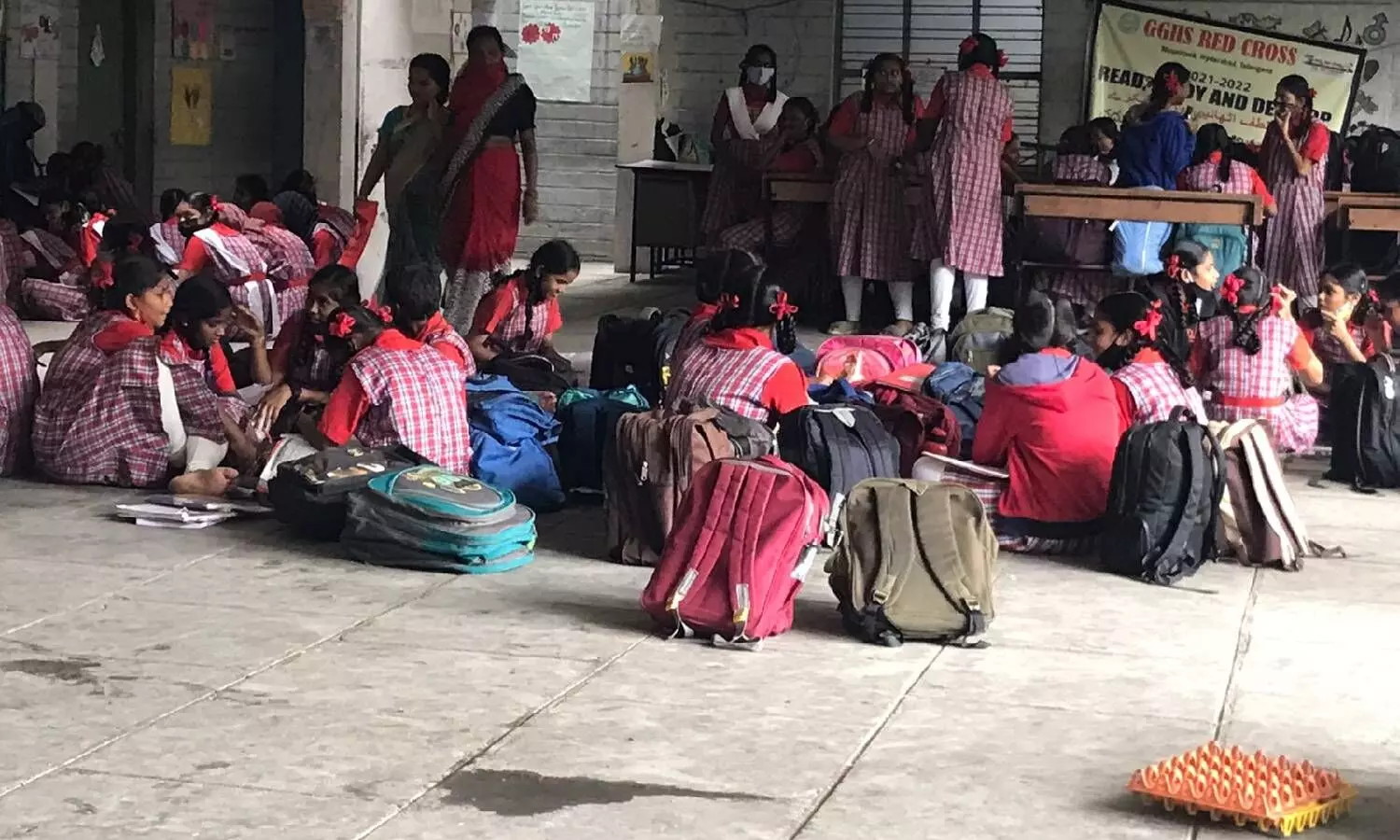'We take turns to sit': No classrooms, no clean toilets, this is the state of a govt school in Masab Tank
In GGHS Masab Tank, the strength of each class is around 90 students. However, each classroom has a seating capacity of only 40-45 students.
By Nimisha S Pradeep
Hyderabad: In an open space at the Government Girls High School (GGHS) in Masab Tank, Hyderabad, more than 100 students sit closely packed in different groups, turning in different directions. While the students of one group are busy finishing their assignments, the students of another group are keenly looking at the blackboard where their teacher is writing. While one group belongs to class VII, the other group of students are from class IX. A different group sits and has the mid-day meal provided by the school.
It is a class of 86 students but only 69 are present today and the students are glad because nobody has to sit down on the floor. Three students sit on each of the 23 benches in the classroom. "Usually, we take turns to sit. One day, one group of students will sit down on the floor and the next day they sit on the benches," Renuka (name changed), a class VII student, explains.
What is even more interesting is that in some of these classes, there is hardly any space to sit and even if there is a little space for the students, there is no space for the teacher to sit. The students sitting down also sometimes face difficulty seeing the board as they sit very close to it.
In GGHS Masab Tank, the strength of each class is around 90 students. However, each classroom has a seating capacity of only 40-45 students. The girls studying in this school are children of rickshaw-pullers, ragpickers, etc., and they all come from the nine slums in the neighbourhood. From classes I to X, there are around 1,000 students – 600 in high school and 400 in primary school. There are only six classrooms for high school students and five classrooms for primary school.
Anjali (name changed), one of the teachers, says the number of students has increased after the pandemic due to students' inability to pay the high fees in private schools. "When I joined here, the strength from classes VI to X was around 200 which is the right capacity for this school. Over the years, it has increased and after the pandemic, it has become 450," she says.
Moreover, high school classes offer three languages – Telugu, Hindi, and Urdu. "If the Telugu class is taking place inside the classroom, then the Hindi and Urdu students will have to sit outside," says Anjali.
She also points out that to pay individual attention to students sometimes the class is split into two and divided between two teachers for one subject. Still, only one class can go on at a time as there are no sufficient classrooms.
'It stinks: Only if it's urgent, we use it'
There are five toilets for primary and five toilets for high school students. But more importantly, they are not in good condition and the students say they use it only when it is "urgent."
"The toilets smell very bad. So, I use it only if it is very urgent," says Architha (name changed), a class VII student. She adds that there are days when she does not use the toilet throughout the day.
Architha also says that nobody comes to clean their classrooms. They clean it themselves.
"Earlier, we used to get Rs. 2,500 for sanitation. Since March 2022, we are not getting the funds," says Anjali.
450 students, 1 teacher
Another issue is the lack of sufficient teachers. For both primary and secondary, there are only 12 teachers.
Neha (name changed), a visually-challenged Social Studies teacher in the school, says she finds it very hard to manage a class of 80 students. "I am 75% visually challenged. I am the only teacher for Social Studies for classes VI to X. That is, I am the only teacher for around 450 students. It is very difficult to concentrate on each student," says Neha.
Pointing at the microphone that she uses to teach she says, "I use this, otherwise my voice is gone by the end of the day."
Anjali, who also holds some key responsibilities of the school, explains how difficult it is to manage both teaching her own subject and handling other official responsibilities. She says funds were allocated as part of the Mana Ooru, Mana Badi programme but due to some problems between the government and the NGO that owns the school building, the funds are not being released.
"When the government has land and funds in their hands, why are they not giving education to the poor children?" asks Syed Bilal, a member of the National Alliance of People's Movement (NAPM). He further says that no government school should be run by an NGO and the government should take after the running of the school.
Besides the school administration giving representations to the district collector and DEO, NAPM also wrote a letter to the minister of education, Sabitha Indra Reddy, and Telangana chief secretary Somesh Kumar on 21 June but they are yet to hear from them.
NewsMeter tried contacting DEO Hyderabad but has not gotten any response yet. The copy will be updated once we hear from her.